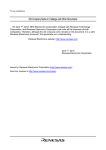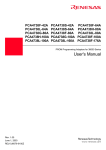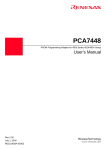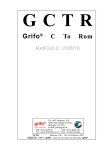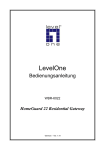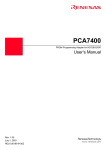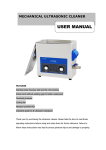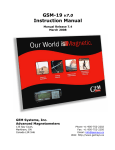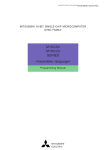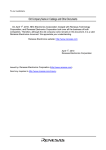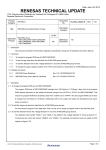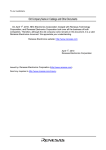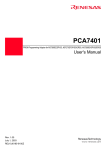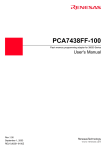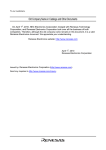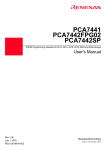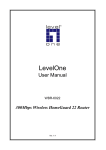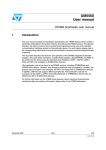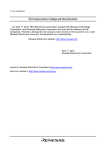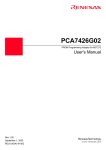Download PCA7477G-100/PCA7477G
Transcript
To our customers, Old Company Name in Catalogs and Other Documents On April 1st, 2010, NEC Electronics Corporation merged with Renesas Technology Corporation, and Renesas Electronics Corporation took over all the business of both companies. Therefore, although the old company name remains in this document, it is a valid Renesas Electronics document. We appreciate your understanding. Renesas Electronics website: http://www.renesas.com April 1st, 2010 Renesas Electronics Corporation Issued by: Renesas Electronics Corporation (http://www.renesas.com) Send any inquiries to http://www.renesas.com/inquiry. Notice 1. 2. 3. 4. 5. 6. 7. All information included in this document is current as of the date this document is issued. Such information, however, is subject to change without any prior notice. Before purchasing or using any Renesas Electronics products listed herein, please confirm the latest product information with a Renesas Electronics sales office. Also, please pay regular and careful attention to additional and different information to be disclosed by Renesas Electronics such as that disclosed through our website. Renesas Electronics does not assume any liability for infringement of patents, copyrights, or other intellectual property rights of third parties by or arising from the use of Renesas Electronics products or technical information described in this document. No license, express, implied or otherwise, is granted hereby under any patents, copyrights or other intellectual property rights of Renesas Electronics or others. You should not alter, modify, copy, or otherwise misappropriate any Renesas Electronics product, whether in whole or in part. Descriptions of circuits, software and other related information in this document are provided only to illustrate the operation of semiconductor products and application examples. You are fully responsible for the incorporation of these circuits, software, and information in the design of your equipment. Renesas Electronics assumes no responsibility for any losses incurred by you or third parties arising from the use of these circuits, software, or information. When exporting the products or technology described in this document, you should comply with the applicable export control laws and regulations and follow the procedures required by such laws and regulations. You should not use Renesas Electronics products or the technology described in this document for any purpose relating to military applications or use by the military, including but not limited to the development of weapons of mass destruction. Renesas Electronics products and technology may not be used for or incorporated into any products or systems whose manufacture, use, or sale is prohibited under any applicable domestic or foreign laws or regulations. Renesas Electronics has used reasonable care in preparing the information included in this document, but Renesas Electronics does not warrant that such information is error free. Renesas Electronics assumes no liability whatsoever for any damages incurred by you resulting from errors in or omissions from the information included herein. Renesas Electronics products are classified according to the following three quality grades: “Standard”, “High Quality”, and “Specific”. The recommended applications for each Renesas Electronics product depends on the product’s quality grade, as indicated below. You must check the quality grade of each Renesas Electronics product before using it in a particular application. You may not use any Renesas Electronics product for any application categorized as “Specific” without the prior written consent of Renesas Electronics. Further, you may not use any Renesas Electronics product for any application for which it is not intended without the prior written consent of Renesas Electronics. Renesas Electronics shall not be in any way liable for any damages or losses incurred by you or third parties arising from the use of any Renesas Electronics product for an application categorized as “Specific” or for which the product is not intended where you have failed to obtain the prior written consent of Renesas Electronics. The quality grade of each Renesas Electronics product is “Standard” unless otherwise expressly specified in a Renesas Electronics data sheets or data books, etc. “Standard”: 8. 9. 10. 11. 12. Computers; office equipment; communications equipment; test and measurement equipment; audio and visual equipment; home electronic appliances; machine tools; personal electronic equipment; and industrial robots. “High Quality”: Transportation equipment (automobiles, trains, ships, etc.); traffic control systems; anti-disaster systems; anticrime systems; safety equipment; and medical equipment not specifically designed for life support. “Specific”: Aircraft; aerospace equipment; submersible repeaters; nuclear reactor control systems; medical equipment or systems for life support (e.g. artificial life support devices or systems), surgical implantations, or healthcare intervention (e.g. excision, etc.), and any other applications or purposes that pose a direct threat to human life. You should use the Renesas Electronics products described in this document within the range specified by Renesas Electronics, especially with respect to the maximum rating, operating supply voltage range, movement power voltage range, heat radiation characteristics, installation and other product characteristics. Renesas Electronics shall have no liability for malfunctions or damages arising out of the use of Renesas Electronics products beyond such specified ranges. Although Renesas Electronics endeavors to improve the quality and reliability of its products, semiconductor products have specific characteristics such as the occurrence of failure at a certain rate and malfunctions under certain use conditions. Further, Renesas Electronics products are not subject to radiation resistance design. Please be sure to implement safety measures to guard them against the possibility of physical injury, and injury or damage caused by fire in the event of the failure of a Renesas Electronics product, such as safety design for hardware and software including but not limited to redundancy, fire control and malfunction prevention, appropriate treatment for aging degradation or any other appropriate measures. Because the evaluation of microcomputer software alone is very difficult, please evaluate the safety of the final products or system manufactured by you. Please contact a Renesas Electronics sales office for details as to environmental matters such as the environmental compatibility of each Renesas Electronics product. Please use Renesas Electronics products in compliance with all applicable laws and regulations that regulate the inclusion or use of controlled substances, including without limitation, the EU RoHS Directive. Renesas Electronics assumes no liability for damages or losses occurring as a result of your noncompliance with applicable laws and regulations. This document may not be reproduced or duplicated, in any form, in whole or in part, without prior written consent of Renesas Electronics. Please contact a Renesas Electronics sales office if you have any questions regarding the information contained in this document or Renesas Electronics products, or if you have any other inquiries. (Note 1) “Renesas Electronics” as used in this document means Renesas Electronics Corporation and also includes its majorityowned subsidiaries. (Note 2) “Renesas Electronics product(s)” means any product developed or manufactured by or for Renesas Electronics. User’s Manual PCA7477G-100 PCA7477G-160 User’s Manual PROM Programming Adapters for M37760FFAGP/M37760FFAGP-160 Rev.1.00 2003.07 * R4944A, R4945 and R4945A are trademarks of Advantest Corporation. Keep safety first in your circuit designs! • Renesas Technology Corporation and Renesas Solutions Corporation put the maximum effort into making semiconductor products better and more reliable, but there is always the possibility that trouble may occur with them. Trouble with semiconductors may lead to personal injury, fire or property damage. Remember to give due consideration to safety when making your circuit designs, with appropriate measures such as (i) placement of substitutive, auxiliary circuits, (ii) use of nonflammable material or (iii) prevention against any malfunction or mishap. Notes regarding these materials • These materials are intended as a reference to assist our customers in the selection of the Renesas Technology product best suited to the customer's application; they do not convey any license under any intellectual property rights, or any other rights, belonging to Renesas Technology Corporation, Renesas Solutions Corporation or a third party. • Renesas Technology Corporation and Renesas Solutions Corporation assume no responsibility for any damage, or infringement of any third-party's rights, originating in the use of any product data, diagrams, charts, programs, algorithms, or circuit application examples contained in these materials. • All information contained in these materials, including product data, diagrams, charts, programs and algorithms represents information on products at the time of publication of these materials, and are subject to change by Renesas Technology Corporation and Renesas Solutions Corporation without notice due to product improvements or other reasons. It is therefore recommended that customers contact Renesas Technology Corporation, Renesas Solutions Corporation or an authorized Renesas Technology product distributor for the latest product information before purchasing a product listed herein. The information described here may contain technical inaccuracies or typographical errors. Renesas Technology Corporation and Renesas Solutions Corporation assume no responsibility for any damage, liability, or other loss rising from these inaccuracies or errors. Please also pay attention to information published by Renesas Technology Corporation and Renesas Solutions Corporation by various means, including the Renesas home page (http://www.renesas.com). • When using any or all of the information contained in these materials, including product data, diagrams, charts, programs, and algorithms, please be sure to evaluate all information as a total system before making a final decision on the applicability of the information and products. Renesas Technology Corporation and Renesas Solutions Corporation assume no responsibility for any damage, liability or other loss resulting from the information contained herein. • Renesas Technology semiconductors are not designed or manufactured for use in a device or system that is used under circumstances in which human life is potentially at stake. Please contact Renesas Technology Corporation, Renesas Solutions Corporation or an authorized Renesas Technology product distributor when considering the use of a product contained herein for any specific purposes, such as apparatus or systems for transportation, vehicular, medical, aerospace, nuclear, or undersea repeater use. • The prior written approval of Renesas Technology Corporation and Renesas Solutions Corporation is necessary to reprint or reproduce in whole or in part these materials. • If these products or technologies are subject to the Japanese export control restrictions, they must be exported under a license from the Japanese government and cannot be imported into a country other than the approved destination. Any diversion or reexport contrary to the export control laws and regulations of Japan and/or the country of destination is prohibited. • Please contact Renesas Technology Corporation or Renesas Solutions Corporation for further details on these materials or the products contained therein. Precautions to be taken when using this product • This product is a development supporting unit for use in your program development and evaluation stages. In mass-producing your program you have finished developing, be sure to make a judgment on your own risk that it can be put to practical use by performing integration test, evaluation, or some experiment else. • In no event shall Renesas Solutions Corporation be liable for any consequence arising from the use of this product. • Renesas Solutions Corporation strives to cope with the issues given below at some charge or without charge. • This product has been developed by assuming its use for program development and evaluation in laboratories. Therefore, it does not fall under the application of Electrical Appliance and Material Safety Law and protection against electromagnetic interference when used in Japan. For inquiries about the contents of this document or product, fill in the text file the installer of the emulator debugger generates in the following directory and email to your local distributor. \SUPPORT\Product-name\SUPPORT.TXT Renesas Tools Homepage http://www.renesas.com/en/tools ( 2 / 14 ) Contents Chapter 1. Things to Check When Unpacking .................................................................................. 4 Chapter 2. Introduction ...................................................................................................................... 4 Chapter 3. Specifications ................................................................................................................... 5 Chapter 4. How to Set the PCA7477G-100/PCA7477G-160 ........................................................... 6 4.1 Attaching the Adapter to a PROM Programmer .............................................................. 6 4.2 Mounting an MCU into the Adapter ................................................................................ 7 4.3 Precautions When Opening and Closing the IC Socket ................................................... 7 4.4 Precautions When Handling the Adapter ......................................................................... 7 Chapter 5. How to Operate the PROM Programmer ......................................................................... 8 5.1 Recommended PROM Programmers ............................................................................... 8 5.2 Setting the Jumper Switch ................................................................................................ 8 5.3 Programming Procedures ................................................................................................. 9 5.4 Precautions for Erasing Flash Memory ............................................................................ 9 Chapter 6. Memory Maps ................................................................................................................ 10 ( 3 / 14 ) Chapter 1. Things to Check When Unpacking This product consists of the following parts listed in Table 1.1. When unpacking, check to see that it contains all of the components shown in Table 1.1 below. Table 1.1 Package components Main unit PCA7477G-100 or PCA7477G-160 Interface unit PCA7477B Connector PCA4738E (32-pin) User's manual This manual Chapter 2. Introduction The PCA7477G-100 is a PROM programming adapter for 7760 Group 100-pin QFP (100P6P-E) and the PCA7477G-160 is a PROM programming adapter for 7760 Group 160-pin QFP (160P6-C). The adapter is a tool that can be used to write programs into an internal PROM of MCUs using a commercially available PROM programmer. Figure 2.1 shows the external view of the PCA7477G-100/PCA7477G-160 and its constituent parts. Applicable MCU: M37760FFAGP (PCA7477G-100) M37760FFAGP-160 (PCA-7477G-160) Figure 2.1 External view of the adapter and its constituent parts ( 4 / 14 ) Chapter 3. Specifications Tables 3.1 and 3.2 list specifications of the PCA7477G-100 and PCA7477G-160. Table 3.1 Specifications of the PCA7477G-100 Applicable MCU M37760FFAGP 8 MHz (Supplied by the ceramic oscillator mounted on the PCA7477G-100) Operating clock frequency Power supply Supplied from Vcc of the PROM programmer PCA7477G-100 Board configuration Board to insert a programmable MCU (IC socket for 100-pin QFP mounted on it) PCA7477B Interface board (Connected by two rows of standard-pitch 18-pin connectors and two rows of standard-pitch 16-pin connectors to the upper and lower boards) PCA4738E Board to connect to the PROM programmer (Standard-pitch 32-pin pin-header mounted) Table 3.2 Specifications of the PCA7477G-160 Applicable MCU M37760FFAGP-160 8 MHz (Supplied by the ceramic oscillator mounted on the PCA7477G-160) Operating clock frequency Power supply Supplied from Vcc of the PROM programmer PCA7477G-160 Board configuration Board to insert a programmable MCU (IC socket for 160-pin QFP mounted on it) PCA7477B Interface board (Connected by two rows of standard-pitch 18-pin connectors and two rows of standard-pitch 16-pin connectors to the upper and lower boards) PCA4738E Board to connect to the PROM programmer (Standard-pitch 32-pin pin-header mounted) ( 5 / 14 ) Chapter 4. How to Set the PCA7477G-100/PCA7477G-160 4.1 Attaching the Adapter to a PROM Programmer Attach the pin No. 1 of the PCA4738E connector (standard-pitch 32-pin pin-header mounted) to the pin No. 1 of the PROM programmer's socket. Be careful when attaching the adapter because incorrect insertion can cause fatal damage to the MCU. Figure 4.1 Attaching the adapter to a PROM programmer ( 6 / 14 ) 4.2 Mounting an MCU into the Adapter As shown in Figure 4.2, insert the No. 1 pin of an MCU into the No. 1 pin of the IC socket on the PCA7477G-100. It is same for the PCA7477G-160. Be careful when inserting the MCU because incorrect insertion can cause fatal damage to the MCU. Figure 4.2 Mounting an MCU 4.3 Precautions When Opening and Closing the IC Socket When opening and closing the IC socket, hold the adapter horizontally as shown in Figure 4.3. Otherwise the inside of the IC socket may become damaged and cause an electrical insulation failure. Figure 4.3 Opening the IC Socket 4.4 Precautions When Handling the Adapter Do not directly touch the connector in the IC socket and the pins on the PROM programmer connector because dirt may cause an electrical insulation failure. ( 7 / 14 ) Chapter 5. How to Operate the PROM Programmer For how to operate the PROM programmer (e.g. setting ROM type, transferring a program, setting areas), refer to its user's manual. 5.1 Recommended PROM Programmers The PROM programmers listed in Table 5.1 are recommended for the PCA7477G-100/PCA7477G160. Using the actual products, we have verified that these PROM programmers can be used to write programs without problem. Nonconformity occurring by using any other PROM programmers can not be supported. For the latest type of PROM programmers, contact the manufacturer to confirm whether it can be used for your product. Table 5.1 Recommended PROM programmers Manufacturer Type name Device Programming voltage (VPP) M5M28F101 mode 12.0 V R4944A Advantest Corporation R4945 R4945A 5.2 Setting the Jumper Switch To write the program into the internal ROM area (02000h--1FFFFh) of the MCU, set the JP1 to R side (see Figure 5.1). To write the program into the OSD ROM area (20000h--227FFh) of the MCU, set the JP1 to O side (see Figure 5.1). OSD ROM area (20000h--227FFh) Internal ROM area (02000h--1FFFFh) JP1 JP1 O R Figure 5.1 Setting JP1 Note: shows the part DIC mounted ( 8 / 14 ) O R 5.3 Programming Procedure Follow the procedures below to write the program into the MCU. (1) Mount the MCU into the adapter PCA7477G-100/PCA7477G-160. (2) According to the ROM type, set the jumper switch (R side: internal ROM, O side: OSD ROM). (3) Attach the adapter PCA7477G-100/PCA7477G-160 to the IC socket of the PROM programmer. Programming into the internal ROM area (02000h--1FFFFh) (4) Read the program into the addresses 02000h--1FFFFh of the PROM programmer. (5) Using the PROM programmer's erase check function, check whether data can be written into the MCU's programming ROM area. (6) Write the program into the programming ROM area of the MCU using the PROM programmer. (addresses 02000h--1FFFFh of the MCU) (7) Verify the programming ROM area of the MCU using the PROM programmer to check whether the program has been written into the MCU correctly. Programming into the OSD ROM area (20000h--227FFh) (4) Read the program into the addresses 00000h--027FFh of the PROM programmer. (5) Using the PROM programmer's erase check function, check whether data can be written into the MCU's programming ROM area. (6) Write the program into the programming ROM area of the MCU using the PROM programmer. (addresses 20000h--227FFh of the MCU) (7) Verify the programming ROM area of the MCU using the PROM programmer to check whether the program has been written into the MCU correctly. Notes * Some PROM programmers perform the steps (5) to (7) automatically. * Be sure to set the programming area. Otherwise the mode's shift to the programming mode may not be performed successfully. The erase check function and others may not also be performed completely. 5.4 Precautions for Erasing Flash Memory When you erase the flash memory, you need to fill in "00h" in the area to be erased in order to prevent an error (the recommended PROM programmers execute this automatically). And also, when you erase the OSD ROM, you need to fill in "00h" in the ROM area reserved for testing (2F000h--2FFFFh) in order to prevent an error. Always erase the ROM area reserved for testing when you erase the OSD ROM. ( 9 / 14 ) Chapter 5. Memory Maps Figures 6.1 and 6.2 show memory maps of the M37760FFAGP-100/M37760FFAGP-160 and the PROM programmer. 00000h 00000h SFR area 001FFh 00200h 00FBFh 00FC0h Cannot be used Serial I/O RAM area 00FFFh 01000h 01BFFh 01C00h Unused area Internal RAM area OSD RAM area 01FFFh 02000h 01FFFh 02000h Internal ROM area Programming area 1FFFFh 20000h 1FFFFh PROM programmer (M5M28F101 mode) OSD ROM area 227FFh 22800h Cannot be used 2EFFFh 2F000h ROM area for testing 2FFFFh PCA7477G-100 PCA7477G-160 Figure 4.1 Memory map (writing into internal ROM) ( 10 / 14 ) 00000h 00000h SFR area 001FFh 00200h 00FBFh 00FC0h OSD ROM area Cannot be used 027FFh 02800h Serial I/O RAM area 00FFFh 01000h 01BFFh 01C00h Unused area Internal RAM area 0EFFFh 0F000h OSD RAM area 01FFFh 02000h ROM area for testing 0FFFFh 10000h Internal ROM area Unused area 1FFFFh 20000h 1FFFFh PROM programmer (M5M28F101 mode) OSD ROM area 227FFh 22800h Cannot be used 2EFFFh 2F000h ROM area for testing 2FFFFh PCA7477G-100 PCA7477G-160 Figure 4.2 Memory map (writing into OSD ROM) ( 11 / 14 ) MEMO ( 12 / 14 ) PCA7477G-100/PCA7477G-160 User's Manual Rev. 1.00 July 1, 2003 REJ10J0178-0100Z COPYRIGHT ©2003 RENESAS TECHNOLOGY CORPORATION AND RENESAS SOLUTIONS CORPORATION ALL RIGHTS RESERVED PCA7477G-100 PCA7477G-160 User’s Manual 1753, Shimonumabe, Nakahara-ku, Kawasaki-shi, Kanagawa 211-8668 Japan REJ10J0178-0100Z
















